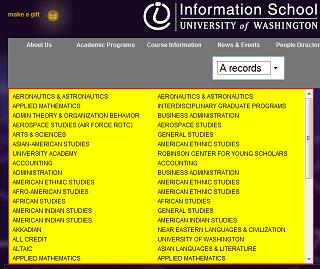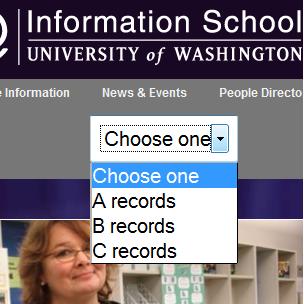 Once word gets around that you can handle HttpRequests and can unpack XML, folks like these (do you see Scott Barker over to the left?) will hire you to develop code for their webpages.
Once word gets around that you can handle HttpRequests and can unpack XML, folks like these (do you see Scott Barker over to the left?) will hire you to develop code for their webpages.
This project extends the project "ABC iSchool course web services". Here, the goal is to put an HTML select widget on the iSchool webpage. The select widget shows courses beginning the letter "a", letter "b" or letter "c".
The challenge would seem to be (1) Targeting an element on the iSchool webpage, (2) Reach out to the the XML file (i.e., aCourses.xml, bCourses.xml, cCourses.xml), (3) Unpack the XML contents, (4) Construct an HTML select widget, (5) Hang it onto the iSchool webpage, and finally, (6) Expropriate some real estate on the iSchool webpage to show the course information.
In short, we're going to grease up the iSchool webpage and make it our own!
Greased! Select an option to get "A" courses

Greased! Select an option to get "B" courses

Greased! Select an option to get "C" courses

Some developer notes
Since we're going to "grease up" (i.e., mash up) the iSchool web page with Greasemonkey, the information that we're going to place on the iSchool web page can live anywhere (e.g.: we're not limited to the iSchool domain). For this project, our XML source documents are here:
- http://projects.ischool.washington.edu/tabrooks/343INFO/abcISCHOOL/aCourses.xml
- http://projects.ischool.washington.edu/tabrooks/343INFO/abcISCHOOL/bCourses.xml
- http://projects.ischool.washington.edu/tabrooks/343INFO/abcISCHOOL/cCourses.xml
Finding a hook on the iSchool webpage
The iSchool webpage is a handsome page that features header DIV

The following script targets this header div and adds my name as a child element.

var ULNodeList;
ULNodeList = document.evaluate(
"//ul[@id='superfish-1']",
document,
null,
XPathResult.UNORDERED_NODE_SNAPSHOT_TYPE,
null);
var nameNode = document.createTextNode("Terry");
var namePara = document.createElement("P");
namePara.appendChild(nameNode);
var nameDiv = document.createElement("DIV");
nameDiv.appendChild(namePara);
var selectStyle = document.createAttribute("style");
selectStyle.nodeValue = "padding: 10px; margin-bottom: 30px; margin-top: 10px; font-size: 20px; background-color: white";
nameDiv.setAttributeNode(selectStyle);
var ULNode;
for (var i = 0; i < ULNodeList.snapshotLength; i++)
{
ULNode = ULNodeList.snapshotItem(i);
ULNode.setAttribute("style", "height: 100px");
var myBR = document.createElement("br");
ULNode.appendChild(myBR);
ULNode.appendChild(nameDiv);
}
What does a clickable select widget look like?
<script type="text/javascript">
function showChoice(inChoice)
{
alert("You just selected " + inChoice);
}
</script>
...
<select>
<option value ="volvo" onclick="showChoice('volvo')">Volvo</option>
<option value ="saab" onclick="showChoice('saab')">Saab</option>
<option value ="opel" onclick="showChoice('opel')">Opel</option>
<option value ="audi" onclick="showChoice('audi')">Audi</option>
</select>
Hang a select widget on the iSchool webpage

The script that puts a select widget on the iSchool webpage.
///////////////////////////////////////////////////////////////////////
// functions called on user choice of records
function doARecords()
{
alert("You want the A records");
}
function doBRecords()
{
alert("You want the B records");
}
function doCRecords()
{
alert("You want the C records");
}
///////////////////////////////////////////////////////////
// Create a new HTML element
var selectElement = document.createElement("select");
var optionO = document.createElement("option");
var optionOText = document.createTextNode("Choose one");
optionO.appendChild(optionOText);
selectElement.appendChild(optionO);
var option1 = document.createElement("option");
var option1ValueAtt = document.createAttribute("value");
option1ValueAtt.nodeValue = "A";
option1.setAttributeNode(option1ValueAtt);
var option1Text = document.createTextNode("A records");
option1.appendChild(option1Text);
option1.addEventListener("click", doARecords, false);
selectElement.appendChild(option1);
var option2 = document.createElement("option");
var option2ValueAtt = document.createAttribute("value");
option2ValueAtt.nodeValue = "B";
option2.setAttributeNode(option2ValueAtt);
var option2Text = document.createTextNode("B records");
option2.appendChild(option2Text);
option2.addEventListener("click", doBRecords, false);
selectElement.appendChild(option2);
var option3 = document.createElement("option");
var option3ValueAtt = document.createAttribute("value");
option3ValueAtt.nodeValue = "C";
option3.setAttributeNode(option3ValueAtt);
var option3Text = document.createTextNode("C records");
option3.appendChild(option3Text);
option3.addEventListener("click", doCRecords, false);
selectElement.appendChild(option3);
////////////////////////////////////////////////////////////////
// Give the select element a little bit of CSS style
var selectStyle = document.createAttribute("style");
selectStyle.nodeValue = "padding: 10px; margin-bottom: 30px; margin-top: 10px; font-size: 20px";
selectElement.setAttributeNode(selectStyle);
/////////////////////////////////////////////////////////
// Placing the select widget
var ULNodeList;
ULNodeList = document.evaluate(
"//ul[@id='superfish-1']",
document,
null,
XPathResult.UNORDERED_NODE_SNAPSHOT_TYPE,
null);
var ULNode;
for (var i = 0; i < ULNodeList.snapshotLength; i++)
{
ULNode = ULNodeList.snapshotItem(i);
ULNode.setAttribute("style", "height: 100px");
ULNode.appendChild(selectElement);
}
Use Greasemonkey's HttpRequest function to get XML file

The script that does this
//////////////////////////////////////////////////////////////////////
// The HttpRequest for the source files
GM_xmlhttpRequest({
method: 'GET',
url: "http://projects.ischool.washington.edu/tabrooks/343INFO/abcISCHOOL/aCourses.xml",
headers: {
'User-agent': 'Mozilla/4.0 (compatible) Greasemonkey',
'Accept': 'application/atom+xml,application/xml,text/xml',
},
onload: function(responseDetails)
{
alert(responseDetails.responseText);
}
});
Replace the big fancy JavaScript image slider with a scrollable DIV

The script that does this:
//////////////////////////////////////////////////////////////
// Target image slider
var imageNodeList;
imageNodeList = document.evaluate(
"//div[@id='featurestories-container-block']",
document,
null,
XPathResult.UNORDERED_NODE_SNAPSHOT_TYPE,
null);
// the slider widget
var bigImageNode;
for (var i = 0; i < imageNodeList.snapshotLength; i++)
{
bigImageNode = imageNodeList.snapshotItem(i);
bigImageNode.innerHTML = " ";
}
///////////////////////////////////////////////////////////////////
// Create scrollable DIV
var tArea = document.createElement("DIV");
tArea.setAttribute("style", "border: solid 2px #ff0000; background: yellow; padding: 4px; width: 600px; height: 340px; overflow: auto");
bigImageNode.appendChild(tArea);
Unpack the XML documents

The script that does this:
GM_xmlhttpRequest({
method: 'GET',
url: "http://projects.ischool.washington.edu/tabrooks/343INFO/abcISCHOOL/aCourses.xml",
headers: {
'User-agent': 'Mozilla/4.0 (compatible) Greasemonkey',
'Accept': 'application/atom+xml,application/xml,text/xml',
},
onload: function(responseDetails)
{
////////////////////////////////////
// Transform string mash page into DOM object
var mashPage = document.createElement('div');
mashPage.innerHTML = responseDetails.responseText;
// Search mash DOM object
var mashNodeList;
mashNodeList = document.evaluate(
"curricula/curriculum",
mashPage,
null,
XPathResult.UNORDERED_NODE_SNAPSHOT_TYPE,
null);
alert(mashNodeList.snapshotItem(1).childNodes[5].firstChild.nodeValue + " - " +
mashNodeList.snapshotItem(1).childNodes[11].firstChild.nodeValue);
}
});